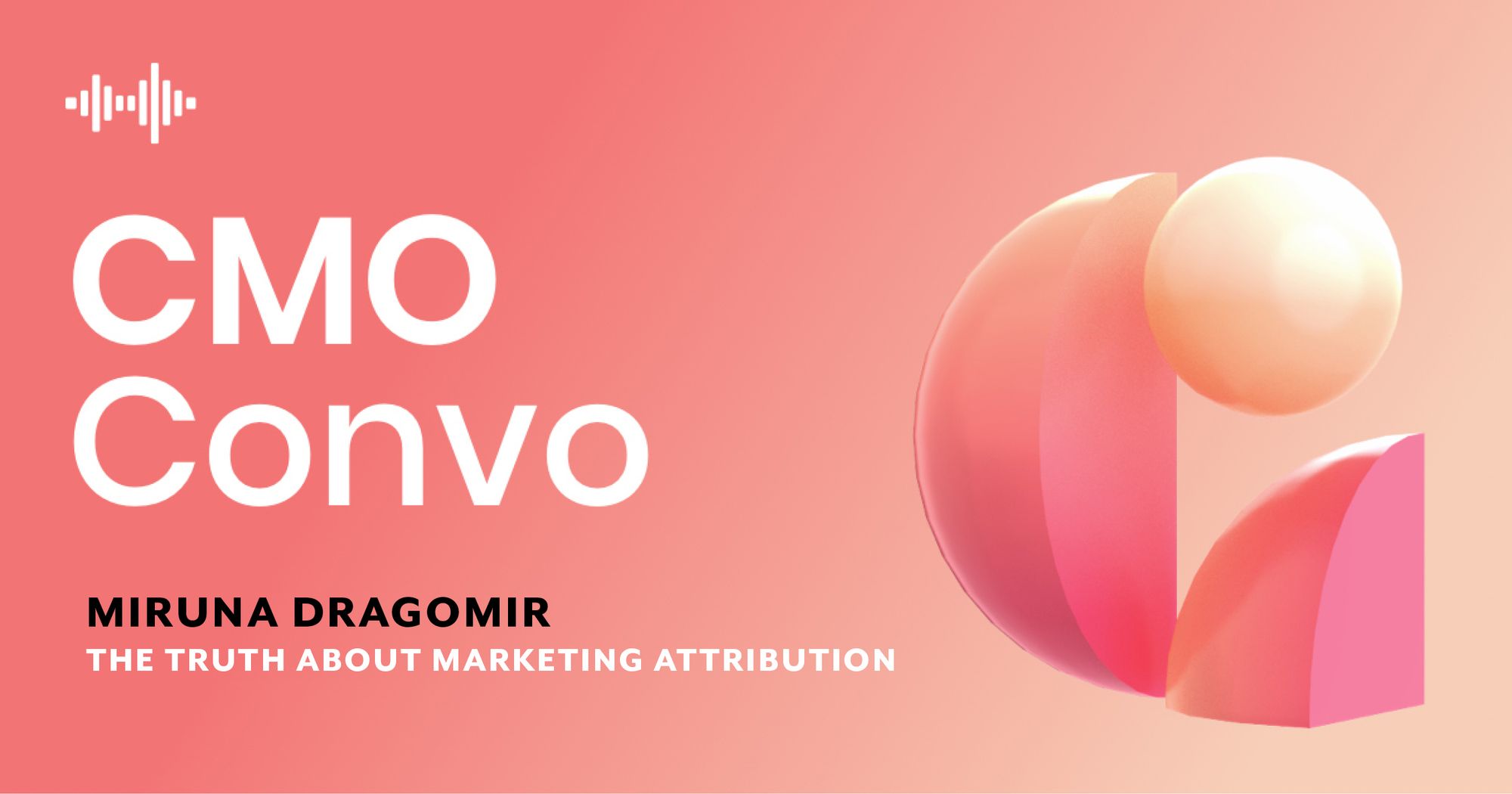Marketing attribution can be a powerful tool for CMOs, by allowing them to show the direct impact their actions have. But certain essential types of marketing (like brand marketing) don't always allow for that, which can often hamstring CMOs when it comes to getting resources.
We spoke to Miruna Dragomir, CMO at Planable, to get the full rundown of the current state of marketing attribution, the scenarios we can and can't use it in, and what the future might hold as new technologies emerge.
Originally an episode of CMO Convo, now available as a full write-up below.

We cover:
- Marketing attribution and its benefits for your company
- Easily attributable activities vs not-so-easily attributable activities
- Showing the value of marketing you can't attribute
- The future of marketing attribution
Marketing attribution and its benefits for your company
Hi Miruna, how are you doing today?
Hi, I'm good. Happy to be here!
We're happy you're here too because we’re going to be talking about a subject that presses on the minds of many CMOs: marketing attribution. It seems like everything has to be attributable these days, but what do we mean by marketing attribution? We're sure most of our readers are familiar with it, but it's worthwhile to clear up what we're going to be talking about.
Marketing attribution means that you can look at your audience through the lens of your funnel and stop at any macro or micro-moment, and see how your activity impacts conversion, behavior, churn, or any other metrics you measure.
This also means that the audience can be segmented. It can be split into channels and looked at through the same lens, so you can look at data not only from a broad perspective but go as granular as possible.
Being able to get granular like that is super important. You mentioned segmentation – that's a huge benefit when it comes to marketing and doing hyper-targeted ads. Are there any other benefits that we need to think about when it comes to marketing attribution?
I think the biggest benefit of them all is the fact that in an ideal world, if all your traffic and all your leads could be attributed to an experiment or a campaign that you did, then you would be able to optimize everything to perfection.
You could cut your losses very quickly if you were doing something that wasn’t working, and you could double down on everything that was working well. In theory, you could reach this perfect marketing in a short time, just based on attribution.
Excellent, and that's not just important to the marketing department, it's beneficial to other departments too. It allows you to show other departments what's going well and how you’re having major impacts on sales. It allows you to show the CFO what kind of actions are gonna be taken and their effects on the bottom line, which is key to getting them onside for projects.
Yeah, and that can increase your budget fast. For the scaling of the company, especially if it's a company that relies on marketing growth, that can be a game-changer.

Easily attributable activities vs not-so-easily attributable activities
What kinds of activities are currently pretty easy for CMOs to attribute?
Performance marketing is one of the easiest ones. That can mean search ads, Google display campaigns, Facebook ads, or any kind of social media ads really. There is a “but” here though.
The advice that's been out there for a while is to use your channels as funnels – to warm up the audience first on Instagram and then double down on Google Display. Or, to put it another way, to attract customers with content first and then give them a product.
This isn’t as easy as the advice would suggest because the technology isn’t there yet. It’s not necessarily possible to target someone with an ebook on Instagram, and then with something else through Google Display ads. So yeah, performance marketing is one of the easier activities to attribute, but there is a “but”.
Yeah, trying to track customers across different channels has got to be difficult, particularly since a lot of the channels don't want you to share data like that. Facebook wants to keep its data on Facebook; LinkedIn wants to keep its data on LinkedIn. But you have to be able to track data this way in an omnichannel experience, so that's gotta be a major challenge.
Yeah, I think part of what makes this frustrating is that sometimes there is this disconnect between what you read as a theory and what is actually possible. You're like, “Wait, what is going on? Why are all these people promoting theories that are not doable?” I mean, they are somewhat applicable, but not with the 100% accuracy that some of us might expect.
Theories are only theories at the end of the day – they’re not necessarily based on the reality of the circumstances that you’re dealing with. It must be especially difficult if your CEO is reading those theories like, “Why isn't the theory matching the reality? What are you doing wrong with this process?”
So you’ve mentioned some of the things that we can attribute. Which marketing activities are more difficult to attribute?
There aren’t a lot of tactics that you simply can't look at data for at all, but each of them comes with a grade for how attributable they are.
A lot of event marketing isn’t entirely attributable just because of how human behavior works. You can go to an event and ask people to scan your QR code or give them discount codes and expect them to look at your website and purchase that way, but human behavior doesn't always work like that. Most people think, “I'll Google that later,” and they might remember it a month on, but it’s hard to attribute that particular visit.
The second factor that makes some marketing activities harder to attribute is that tech doesn't always work how we want it to. It can fail you on the direct traffic, which can be a massive issue for CMOs and marketing teams. A big chunk of your traffic might be coming from a direct source, but you have no idea what that source is. You can guess, of course, but you might not know for sure.

Showing the value of marketing you can't attribute
Since the buying cycle can be so long, particularly in B2B, you might not ever know when your brand came onto another company’s radar. It’s got to be difficult for marketers to explain to other stakeholders that you might not see the fruits of your marketing labor for months or even years
For sure. It's tough to explain without it looking like you're making excuses for your failures. It's difficult to ask for patience as well in this very fast climate that we're living in. We all want exponential growth in a matter of months, so when you say, ”But we don't know whether this tactic works or not,” then you face impatience.
I don't want to frame this as a battle between the CMO and the evil stakeholders because each and every one of us has our own ways of looking at things, and it's normal for other members of the organization to want fast results. I want fast results too; they’re just not always that easy to deliver.
Let's talk about those conversations you can have, as you said, not to make excuses but to manage expectations on non-attributable marketing. How do you explain to stakeholders in terms that they'll appreciate that you might not be able to see the benefits in a month?
I think the first thing is for you to decide your position on the tactic you’re using. Do you believe in it 100%? Or 90%? Are you almost sure that it's working, even if it's unattributable?
And then, ideally, you want to show causality. That's what attribution does: it shows you exactly what you did that caused someone to do something – that’s the gold standard when it comes to proving results and getting other stakeholders on board.
If you can’t show causality, you can sometimes show correlation. It's not great, it's not scientific, and you shouldn’t abuse it, but it is a potential way to show that something is working. For example, maybe you’re attending an event in mid-March, and you have five years of data showing that mid-March never ever means anything special. If this year you do see a spike in activity, it's probably from the event.
Like I said though, correlation is only useful if you don’t abuse it. I saw a case study on a company whose marketing team always did a major campaign during Christmas and they used correlation to justify it. Their numbers were always great around Christmas, and that had to be down to the campaigns right? Maybe not. People go on shopping sprees at Christmas, so they would probably get those numbers anyway.
And then there's another option for if you doubt your tactics or correlation can’t help you. You can always experiment with not doing something that you usually do recurrently. If you do 10 things that are not trackable at the moment, stop them one by one, wait a couple of months, and see how that impacts growth.
You can use this method for other metrics too, not just growth. You can look at traffic, you can look at mentions, you can look at your brand search traffic. Choose the metric that you think the tactic influences the most, and see how that goes. If you doubt its effectiveness, then you should feel comfortable just stopping an activity for a while and seeing what happens
That's an interesting approach to take, particularly for stuff that costs money. If you're spending a lot on something that isn’t attributable, then stopping it to see if it's actually making a difference can be very effective, and I'm sure your CFO would appreciate you taking those kinds of steps as well.
Yeah. We actually did this at one point. I joined Planable very early on, and at the beginning, we didn’t have analytics or a lot of attributable leads. We were just starting out, and we had a few visitors, so it wasn't even a priority at that time. And then it was a long journey to getting analytics in place, during which time we did a lot of things in marketing.
So once we had analytics and enough time had passed for us to have some historical data, we looked at it. One of the tactics that we were putting a lot of time into because we were convinced that it was the biggest contributor to our growth just didn’t seem to be working like we thought it was.
At first, I thought that the tactic must just not be directly attributable, that it was more about raising awareness and word of mouth, and that it was indirectly bringing customers to us. Those customers had to be coming from somewhere, right?
But then I stopped it. I didn’t stop it entirely. But we started putting in about 10% of what we had been putting in until then. And then, after about six months of not doing it at all, I realized that we needed to rethink what we were doing in terms of who we were trying to attract, the promotion tactics, all of that.
It kind of goes back to what we were talking about earlier – putting theories into practice. You might see thought leadership pieces about certain processes that you should be doing and how effective they can be. You might put these theories into practice but if you don’t test them, you can’t know if they’re working.

The future of marketing attribution
Something intriguing you mentioned earlier was that the tech isn’t always there when it comes to attribution. Is that likely to change in the future, particularly with AI models? If you can pump enough data into AI on a large enough scale over enough time, surely you'll be able to attribute everything. Do you think that's on the horizon for marketers?
I think if you’d asked me a year ago, I'd probably have said hell yeah. Now, I think in the next few years we'll see a constant battle between attributable marketing and privacy because that's something that is huge right now. A lot of measures are being taken to enhance privacy, and that is already impacting marketing.
There are even some things that I can’t believe were accessible just a short time back. For example, I don't know what year this changed, but at some point, you could see from exactly which keyword each visitor got to your website, which feels like science fiction now.
With all the privacy measures, that's no longer a thing. It's not accessible for organic traffic at least. The technology is there, but it's not possible to use it. So I think we will continue seeing this kind of battle between privacy and the need for attribution, and for every privacy measure that will be taken, we'll see some sort of workaround. It's more like a chase of trying to fulfill both needs.
We'll for sure see improvements too. I don't think that's in question. There are still things that are impossible right now, like anonymous data, where you don't need any kind of private information, you just need a unique ID to track your audience on different channels, as we said earlier. That's missing now, and I don't know if that would cross too many privacy boundaries.
Great point. We’ll just have to wait and see how it all pans out. Thank you very much for speaking to us today, Miruna!
Need advice when it comes to marketing attribution? Got some expert advice to share? Join the conversation on the CMO Alliance Community Slack channel to share advice and insights with CMOs around the world.




 Follow us on LinkedIn
Follow us on LinkedIn




